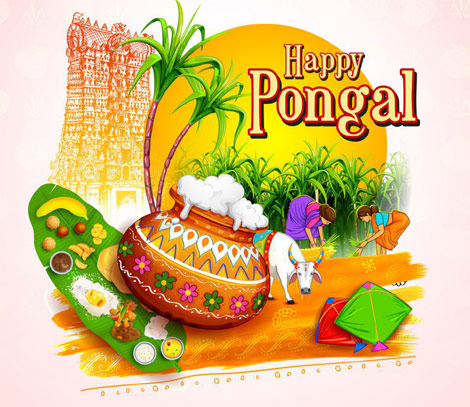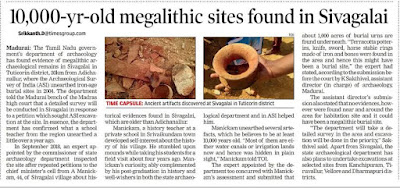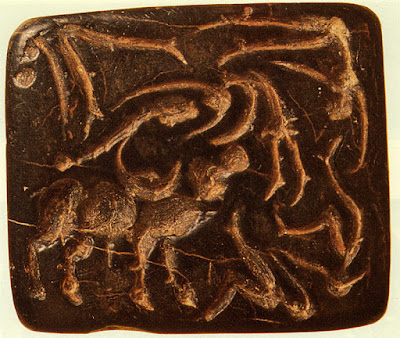In addition to this harvest festival, Pongal is also prepared as prasadam for worshiping Kula Deivam / Kula Devata. Kula Deivam, is one family's Guradian Deity. Kulam / Kula - meaning lineage / clan, deivam / devata - meaning God. It is a strong belief among South Indians that worshiping kula deivam will save our family from all types of harms, evils and hindrances, and will also take care of our family. Every family will go together and visit their guardian deity at least once in an year and worship them by preparing 'Pongal' in the temple premises. Will pen down a separate detail post about Kula Deivam worship.
 |
| Pongal celebration at Temple |
In Some places, they also offer a portion of the yield by exhibiting Nellmudi and offer it to God Ayyanar. Ayyanar is Gramma devata, Village deity, he is worshiped for protecting the lands from all calamities.
Pongal Meaning
Pongal meaning 'Overflowing' / 'boil over', signifying overflowing prosperity and happiness in the family and society as it's the harvest season. Pongal is also celebrated as Makar Sankranthi and Uttarayan in other parts of India. 'Uttarayan' is six month period where the Sun travels towards North, starting on this day
Why Pongal is prepared for this festival??
Why Pongal has to be prepared for this harvest festival? Tamil Nadu is rich in Rice production. The delta region of Kaveri River is 'Thanjavur', also called as 'Rice Bowl of Tamil Nadu' and regions near Tamirabarani river were named after Rice. Agriculture was the main vocation of the Tamils, It was considered as a necessity for life, hence was treated as the foremost among all occupations. the farmers or the Uzhavars were placed right at the top of the social classification.
As Rice and Sugarcane would be harvested in this season (Thai), in order to express gratitude to Gods, part of freshly yielded rice was offered to them as Prasad. Instead of giving raw rice, it was prepared as Prasadham in the form of Pongal. In an Earthenware pot, the newly harvested rice was cooked in rich milk and water. Milk signifies prosperity and purity, as the milk overflows, let the yields also overflow in this harvest season. The pot with milk will be placed facing east direction to God Surya, once it boiled and overflows from the pot, all the people / family members will shout "Pongalo Pongal !! Pongalo Pongal !!".


In addition to Milk Pongal, Sweet Pongal will also be offered to God. For Sweet Pongal new rice and Moong Dal is cooked with milk and water, then Jaggery, ghee, nuts and cardamom will be added for sweetness and taste. Dal signifies Wealth, Jaggery signifies Happiness and ghee signifies Victory. This is the reason for the Pongal being prepared for the Harvest Festival, to offer some portions of the harvested yields to God in a sweet way. Along with Pongal, freshly harvested Sugarcane, Tumeric and Ginger plants are also kept as offer to Gods.
A special puja is performed on the first day of Pongal before the cutting of the paddy. Farmers worship the sun and the earth by applying sandal wood paste and turmeric on their ploughs and sickles. With these consecrated tools, the newly-harvested rice will be cut.
Ancient sites of Paddy Cultivation
In Porunarattrupadai -240-45, it is mentioned about the paddy cultivation in Tamizhalakam,
கூனி, குயத்தின் வாய் நெல் அரிந்து,
சூடு கோடாகப் பிறக்கி, நாள்தொறும்,
குன்று எனக் குவைஇய குன்றாக் குப்பை
கடுந் தெற்று மூடையின் இடம் கெடக் கிடக்கும்,
சாலி நெல்லின், சிறை கொள் வேலி,
ஆயிரம் விளையுட்டு ஆக,
காவிரி புரக்கும் நாடு கிழவோனே.
Meaning: Matured paddy which is about to ready for harvest in Kaveri delta region and talks about heap of yielded rice as Aayiram veli (Aayiram- one thousand, the measurement unit veli is unknown)
The famous ancient and megalithic site Adichanallur is situated near the river Tamirabharani in between a huge land of paddy cultivation. In addition to Thanjavur, Tamirabharani is also a prime source of paddy cultivation. Adichanallur (Adi - meaning a primitive, Nel - Paddy, oor - village), this site close to 'Korkai', the capital and port city of Early Pandya Kings. Tirunelveli is also closer to Adichanallur, which is named after Paddy cultivation as Thiru - Sacred, Nel - Paddy, Veli - fence. It was also called as Marutha Veli in earlier days. Historians believed that Marutha Veli was the capital of Early Pandya Kingdom before they sworn Madurai as capital during third Tamizh Sangam.
The Chief deity in Tirunelveli is Lord Nellaiyappar (Lord Shiva), he is named after paddy, as he believed to be protected farmer's rice crop over there. Nel - Rice, Appar - Father / Lord. As, this city is an ancient settlement of early Pandya kings, it is also called as 'TenPandya Nadu' / 'TenPandya Semmai'.
Paddy Cultivation in Tamizhakam dating back to.....
The places Adichanallur, Tirunelveli, Nellaiappar temple etc were named after rice and ruled by Early Pandya kings. Tools used for agriculture were also excavated from the site, Evidence of rice is seen in these megalithic sites such as Adichanallur and Porunthal site (near Pazhani). Before the cultivation of Paddy, Tamizh people had cultivated millets and lentils in abundance in Tamil Nadu, so agriculture is not new to Tamizh people.
Carbonised Paddy in a pot was unearthed from a place Agaram (near Keeladi) and Sivagalai in Thothukudi, by Archaeologists of Tamil Nadu. Sivagalai is ancient megalithic site, the artifacts unearthed from Sivagalai is believed to be 10,000 years old. The ancient sites Adichanallur and Sivagalai is considered as historical treasure of Ancient Tamizh Civilization.
Now, coming back to Pongal, in early records, Pongal is appeared as ponakam, tiruponakam, ponkal and similar terms. Pongal celebrations can be at least dated back to 3,000 years old as the proof proposes that there are inscriptions of detailed Pongal recipes mentioned in some Hindu temples of Chola period.
Chola Kings predominantly ruled the Thanjavur delta region, where the Rice crops were grown in abundance, there was a line mentioned in tamil literature that ' The harvested rice crops were arranged like several heaps. Each heaps will be a looking like a mountain through which even an elephant can hide'. So, Pongal festival was celebrated in much pomp and rigors during Chola period.
The inscriptions found in the renowned Lord Veeraraghava temple at Tiruvallur mentions that Chola King Kiluttunga had the practice of gifting land to the temple as part of the Pongal celebrations. The inscription of the Thiruvallur temple shows that on this day, a variety of donations were given to the poor by the Kilutunga king on this day.























